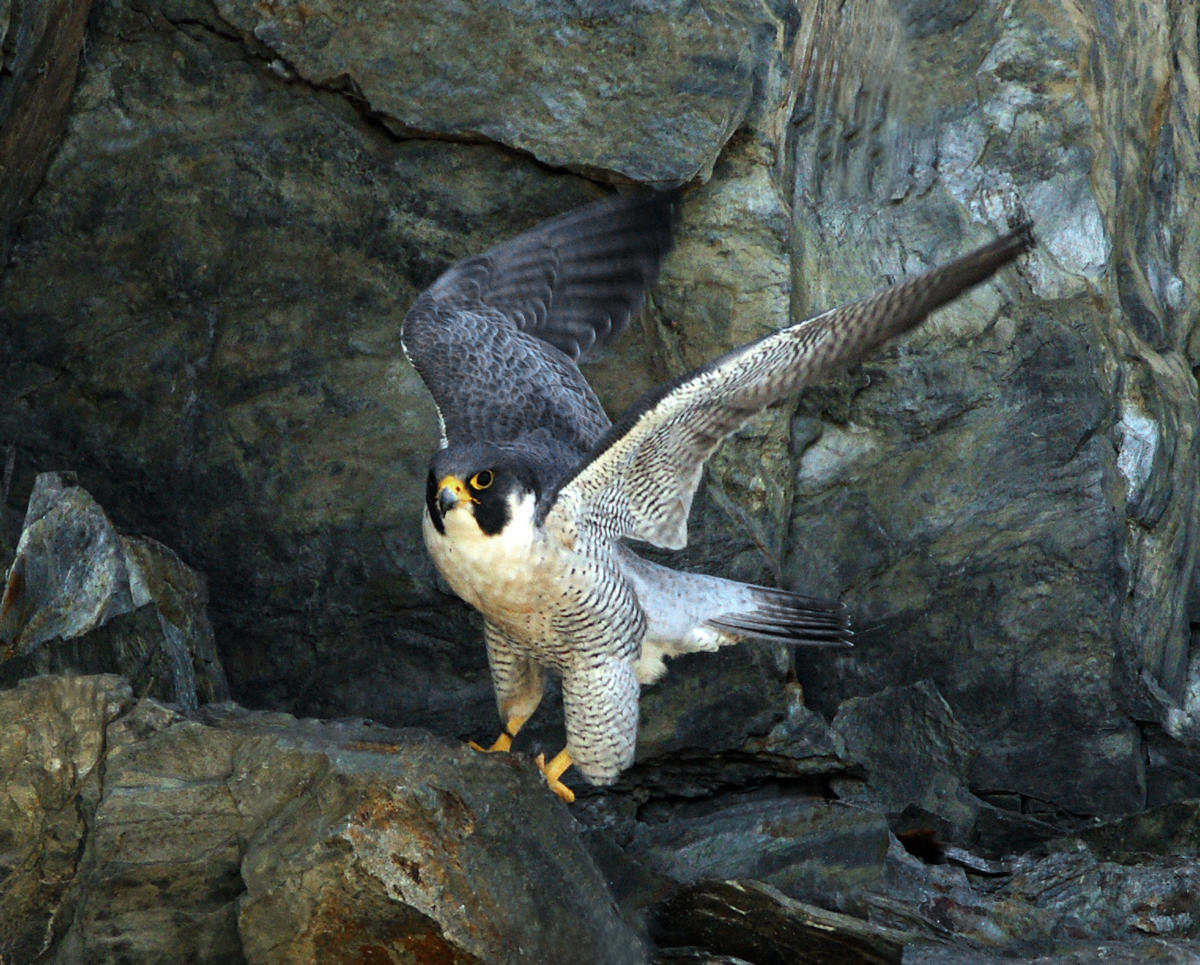Stamp: Falco peregrinus, overprinted (Sudetenland 1938)
Falco peregrinus, overprinted (Sudetenland 1938)
08 October (Sudetenland ) within release Vratislavice nad Nisou (Maffersdorf) goes into circulation Stamp Falco peregrinus, overprinted face value 50 Czechoslovak haléř
| Stamp Falco peregrinus, overprinted in catalogues | |
|---|---|
| Michel: | Mi: DR-SL MA 127 |
Stamp is vertical format.
Blackbrown Handstamp "Wir sind frei!" and swastika on Mi:CS 387Also in the issue Vratislavice nad Nisou (Maffersdorf):
- Stamp - Banská Bystrica, overprinted face value 1.50;
- Stamp - Banská Bystrica, overprinted face value 1.50;
- Stamp - Bratislava, overprinted face value 10;
- Stamp - Český Raj, overprinted face value 3;
- Stamp - Czechoslovak Coat of Arms, overprinted face value 5;
- Stamp - Czechoslovak Coat of Arms, overprinted face value 10;
- Stamp - Czechoslovak Coat of Arms, overprinted face value 30;
- Stamp - Czechoslovak Coat of Arms, overprinted face value 10;
- Stamp - Czechoslovak Coat of Arms, overprinted face value 20;
- Stamp - Czechoslovak Coat of Arms, overprinted face value 25;
- Stamp - Dr. Edvard Beneš, overprinted face value 50;
- Stamp - Handstamp on Benes face value 50;
- Stamp - Jan Ámos Komenský, overprinted face value 40;
- Stamp - Kutna Hora, overprinted face value 1.60;
- Stamp - Lazne Poděbrady, overprinted face value 4;
- Stamp - Mukačevo, Palanok, overprinted face value 1.20;
- Stamp - Olomouc, overprinted face value 5;
- Stamp - Prague, overprinted face value 10;
- Stamp - Slavkov u Brna, overprinted face value 3.50;
- Stamp - Stefanik, overprinted face value 60;
- Stamp - Strečno, overprinted face value 2.50;
- Stamp - Zvíkov, overprinted face value 2;
- Stamp - Zvíkov, overprinted face value 2;
- Stamp - Antonín Leopold Dvořák, overprinted face value 50;
- Stamp - Arras Monument, overprinted face value 1;
- Stamp - Arras Monument, overprinted face value 2;
- Stamp - B.I.T. 1937, overprinted face value 1.50;
- Stamp - B.I.T. 1937, overprinted face value 2;
- Stamp - Battle at Zborov, Ukraine, overprinted face value 50;
- Stamp - Battle in Bachmac (Russia), overprinted face value 50;
- Stamp - Battle in Dos Alto (Italy), overprinted face value 50;
- Stamp - Battle in Vouziers (France), overprinted face value 50;
- Stamp - Battle of Zborov, overprinted face value 1;
- Stamp - Cathedral of St Vitus in Prague, overprinted face value 2.50;
- Stamp - Czechoslovak Dove in Flight, overprinted face value 5;
- Stamp - Czechoslovak Dove in Flight, overprinted face value 10;
- Stamp - Czechoslovak Dove in Flight, overprinted face value 12;
- Stamp - Czechoslovak Dove in Flight, overprinted face value 20;
- Stamp - Czechoslovak Dove in Flight, overprinted face value 50;
- Stamp - Czechoslovak Dove in Flight, overprinted face value 1;
- Stamp - Czechoslovak Newspaper Stamp, overprinted face value 50;
- Stamp - Czechoslovak Newspaper Stamp, overprinted face value 30;
- Stamp - Czechoslovak Personal Delivery Stamp, overprinted face value 50;
- Stamp - Czechoslovak Personal Delivery Stamp, overprinted face value 50;
- Stamp - Czechoslovak Personal Delivery Stamp, overprinted face value 50;
- Stamp - Czechoslovak Personal Delivery Stamp, overprinted face value 50;
- Stamp - Czechoslovak Postage Due Stamp, overprinted face value 5;
- Stamp - Czechoslovak Postage Due Stamp, overprinted face value 10;
- Stamp - Czechoslovak Postage Due Stamp, overprinted face value 20;
- Stamp - Czechoslovak Postage Due Stamp, overprinted face value 30;
- Stamp - Czechoslovak Postage Due Stamp, overprinted face value 40;
- Stamp - Czechoslovak Postage Due Stamp, overprinted face value 50;
- Stamp - Czechoslovak Postage Due Stamp, overprinted face value 60;
- Stamp - Czechoslovak Postage Due Stamp, overprinted face value 1;
- Stamp - Dr. Edvard Beneš (1884-1948), president, by BIT, overprinted face value 50;
- Stamp - Falco peregrinus, overprinted face value 50;
- Stamp - Falco peregrinus, overprinted face value 1;
- Stamp - Fokker F VIIIb, 3 m, overprinted face value 50;
- Stamp - Fokker F VIIIb, 3 m, overprinted face value 1;
- Stamp - General Milan Rastislav Štefánik, overprinted face value 50;
- Stamp - Jan Evangelista Purkyně, overprinted face value 50;
- Stamp - Jan Evangelista Purkyně, overprinted face value 1;
- Stamp - Jindrich Fügner, overprinted face value 50;
- Stamp - Jindrich Fügner, overprinted face value 1;
- Stamp - Jindrich Fügner, overprinted face value 2;
- Stamp - Košice, overprinted face value 50;
- Stamp - Lullaby, overprinted face value 2+1;
- Souvenir Sheet - Masaryk with child, surcharged face value 2+3;
- Stamp - Masaryk with child, surcharged face value 2+3;
- Souvenir Sheet - Masaryk with child, surcharged face value 2+3;
- Stamp - Miroslav Tyrš, overprinted face value 60;
- Stamp - Monument of K. H. Mácha, overprinted face value 50;
- Stamp - Monument of K. H. Mácha, overprinted face value 1;
- Stamp - Mother with the child, relief detail of Lullaby, overprinted face value 1.50;
- Stamp - Plane over Hradcany, overprinted face value 20;
- Stamp - Plane over Hradcany, overprinted face value 20;
- Stamp - Plzeň, overprinted face value 50;
- Stamp - S.Sucharda: Mother with the child, overprinted face value 50+50;
- Stamp - Smolíks Letov S 19, overprinted face value 2;
- Stamp - Smolíks Letov S 19, overprinted face value 3;
- Stamp - Smolíks Letov S 19, overprinted face value 5;
- Stamp - Smolíks Letov S 19, overprinted face value 10;
- Stamp - Smolíks Letov S 19, overprinted face value 4;
- Stamp - Tomáš Garrigue Masaryk (1850-1937), overprinted face value 2;
- Stamp - Tomáš Garrigue Masaryk with Child, overprinted face value 50+50;
- Stamp - Tomáš Garrigue Masaryk with Child, overprinted face value 1+0.50;
- Stamp - Tomáš Garrigue Masaryk, overprinted face value 50;
Stamp Falco peregrinus, overprinted it reflects the thematic directions:
Animals are multicellular, eukaryotic organisms of the kingdom Animalia (also called Metazoa). All animals are motile, meaning they can move spontaneously and independently, at some point in their lives. Their body plan eventually becomes fixed as they develop, although some undergo a process of metamorphosis later on in their lives. All animals are heterotrophs: they must ingest other organisms or their products for sustenance.
Birds (Aves), a subgroup of Reptiles, are the last living examples of Dinosaurs. They are a group of endothermic vertebrates, characterised by feathers, toothless beaked jaws, the laying of hard-shelled eggs, a high metabolic rate, a four-chambered heart, and a strong yet lightweight skeleton. Birds live worldwide and range in size from the 5 cm (2 in) bee hummingbird to the 2.75 m (9 ft) ostrich. They rank as the class of tetrapods with the most living species, at approximately ten thousand, with more than half of these being passerines, sometimes known as perching birds. Birds are the closest living relatives of crocodilians.
Birds of prey or predatory birds, also known as raptors, are hypercarnivorous bird species that actively hunt and feed on other vertebrates (mainly mammals, reptiles and smaller birds). In addition to speed and strength, these predators have keen eyesight for detecting prey from a distance or during flight, strong feet with sharp talons for grasping or killing prey, and powerful, curved beaks for tearing off flesh. Although predatory birds primarily hunt live prey, many species (such as fish eagles, vultures and condors) also scavenge and eat carrion
Adult falcons have thin, tapered wings, which enable them to fly at high speed and change direction rapidly. Fledgling falcons, in their first year of flying, have longer flight feathers, which make their configuration more like that of a general-purpose bird such as a broad wing. This makes flying easier while learning the exceptional skills required to be effective hunters as adults.




